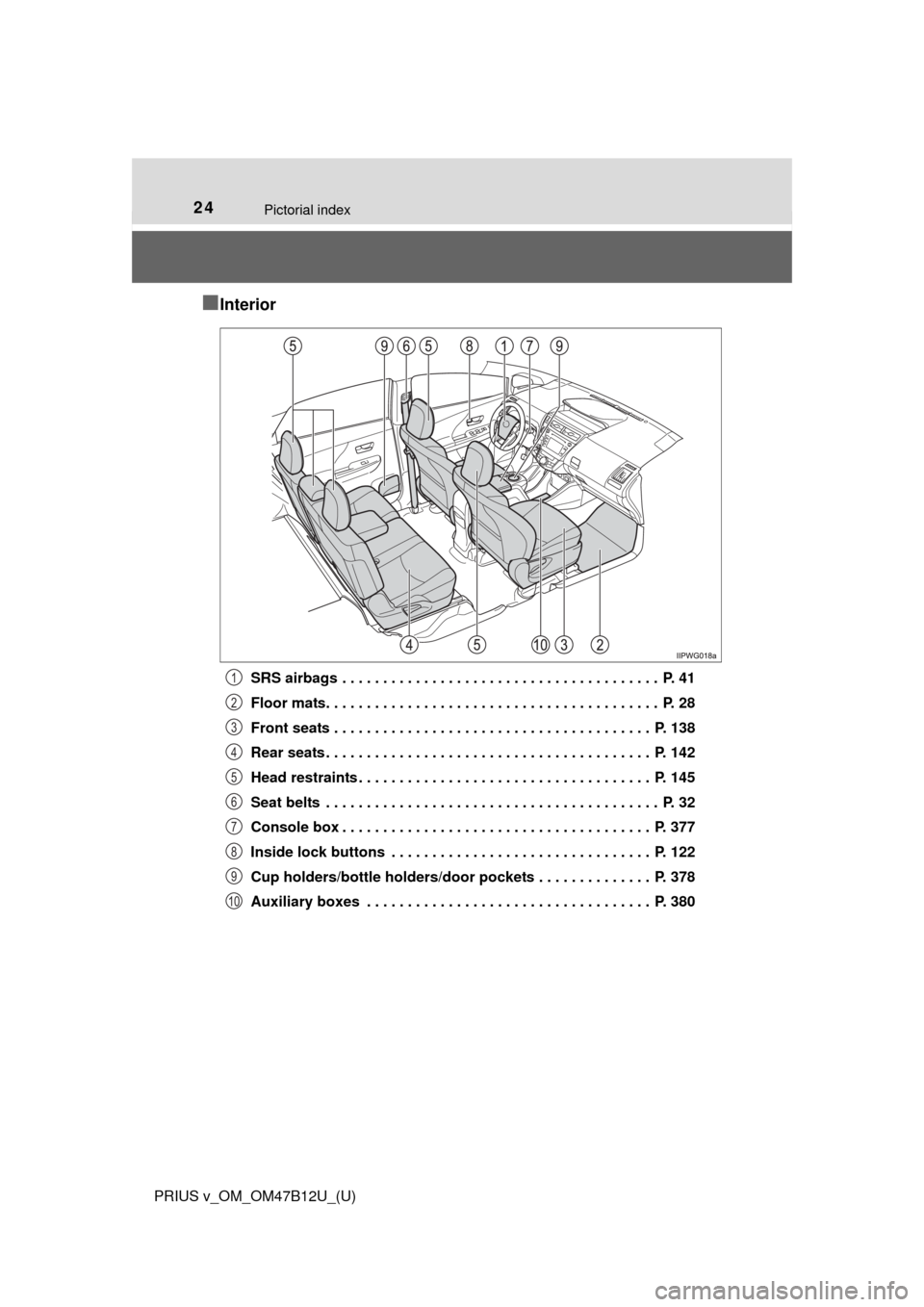belt TOYOTA PRIUS V 2016 ZVW40 / 1.G Owners Manual
[x] Cancel search | Manufacturer: TOYOTA, Model Year: 2016, Model line: PRIUS V, Model: TOYOTA PRIUS V 2016 ZVW40 / 1.GPages: 620, PDF Size: 29.83 MB
Page 1 of 620

PRIUS v_OM_OM47B12U_(U)
Pictorial indexSearch by illustration
1For safety
and securityMake sure to read through them
2Instrument
clusterHow to read the gauges and meters, the variety of
warning lights and indicators, etc.
3Operation of
each componentOpening and closing the doors and windows,
adjustment before driving, etc.
4DrivingOperations and advice which are necessary for
driving
5Audio systemOperating the audio system
6Interior featuresUsage of the interior features, etc.
7Maintenance
and careCaring for your vehicle and maintenance
procedures
8When trouble
arisesWhat to do in case of malfunction or emergency
9Vehicle
specificationsVehicle specifications, customizable features, etc.
10For ownersReporting safety defects for U.S. owners, and seat
belt and SRS airbag instructions for Canadian
owners
IndexSearch by symptom
Search alphabetically
Page 2 of 620

TABLE OF CONTENTS2
PRIUS v_OM_OM47B12U_(U)For your information....................... 8
Reading this manual .................... 14
How to search .............................. 15
Pictorial index .............................. 16
1-1. For safe use
Before driving ...................... 28
For safety drive ................... 30
Seat belts ............................ 32
SRS airbags ........................ 41
Front passenger occupant
classification system ......... 52
Safety information for
children ............................. 57
Child restraint systems ........ 58
Installing child restraints ...... 62
Exhaust gas precautions ..... 72
1-2. Hybrid system
Hybrid system features ....... 73
Hybrid system
precautions ....................... 77
1-3. Theft deterrent system
Immobilizer system ............. 822. Instrument cluster
Warning lights and
indicators ........................... 86
Gauges and meters ............. 91
Multi-information display .... 100
Energy monitor/
consumption screen ........ 108
3-1. Key information
Keys................................... 116
3-2. Opening, closing and
locking the doors
Side doors ......................... 120
Back door .......................... 125
Smart key system .............. 130
3-3. Adjusting the seats
Front seats......................... 138
Rear seats ......................... 142
Head restraints .................. 145
1For safety and security
2Instrument cluster
3Operation of each
component
Page 7 of 620

7
1
9 8
7
6 4 3
2
PRIUS v_OM_OM47B12U_(U)
10
5
8-1. Essential information
Emergency flashers .......... 482
If your vehicle has to
be stopped in an
emergency ...................... 483
8-2. Steps to take in an
emergency
If your vehicle needs to
be towed ......................... 484
If you think something is
wrong .............................. 489
If a warning light turns on
or a warning buzzer
sounds ............................ 490
If a warning message is
displayed ......................... 503
If you have a flat tire .......... 521
If the hybrid system will
not start ........................... 534
If the electronic key does
not operate properly ........ 536
If the 12-volt battery is
discharged ...................... 538
If your vehicle overheats ... 543
If the vehicle becomes
stuck................................ 5489-1. Specifications
Maintenance data
(fuel, oil level, etc.) .......... 552
Fuel information ................. 561
Tire information.................. 564
9-2. Customization
Customizable features ....... 575
9-3. Initialization
Items to initialize ................ 583
Reporting safety defects
for U.S. owners ........................ 586
Seat belt instructions
for Canadian owners
(in French)................................ 587
SRS airbag instructions
for Canadian owners
(in French)................................ 589
What to do if...
(Troubleshooting) ..................... 600
Alphabetical index ...................... 603
8When trouble arises9Vehicle specifications
10For owners
Index
For vehicles with a navigation system, refer to the “NAVIGATION
SYSTEM OWNER’S MANUAL” for information regarding the equip-
ment listed below.
• Navigation system• Audio/visual system
Page 9 of 620

PRIUS v_OM_OM47B12U_(U)
9
The installation of a mobile two-way radio system in your vehicle could affect
electronic systems such as:
●Multiport fuel injection system/sequential multiport fuel injection system
●Dynamic radar cruise control system
●Cruise control system
●Anti-lock brake system
●SRS airbag system
●Seat belt pretensioner system
Be sure to check with your Toyota dealer for precautionary measures or spe-
cial instructions regarding installation of a mobile two-way radio system.
High voltage parts and cables on the hybrid vehicles emit approximately the
same amount of electromagnetic waves as the conventional gasoline pow-
ered vehicles or home electronic appliances despite of their electromagnetic
shielding.
Unwanted noise may occur in the reception of the mobile two-way radio.
Installation of a mobile two-way radio system
Page 11 of 620

PRIUS v_OM_OM47B12U_(U)
11
This vehicle is equipped with an event data recorder (EDR). The main pur-
pose of an EDR is to record, in certain crash or near crash-like situations,
such as an air bag deployment or hitting a road obstacle, data that will assist
in understanding how a vehicle’s systems performed. The EDR is designed to
record data related to vehicle dynamics and safety systems for a short period
of time, typically 30 seconds or less.
The EDR in this vehicle is designed to record such data as:
• How various systems in your vehicle were operating;
• Whether or not the driver and passenger safety belts were buckled/fas-
tened;
• How far (if at all) the driver was depressing the accelerator and/or brake
pedal; and,
• How fast the vehicle was traveling.
These data can help provide a better understanding of the circumstances in
which crashes and injuries occur.
NOTE: EDR data are recorded by your vehicle only if a nontrivial crash situa-
tion occurs; no data are recorded by the EDR under normal driving conditions
and no personal data (e.g., name, gender, age, and crash location) are
recorded. However, other parties, such as law enforcement, could combine
the EDR data with the type of personally identifying data routinely acquired
during a crash investigation.
To read data recorded by an EDR, special equipment is required, and access
to the vehicle or the EDR is needed. In addition to the vehicle manufacturer,
other parties, such as law enforcement, that have the special equipment, can
read the information if they have access to the vehicle or the EDR.
●Disclosure of the EDR data
Toyota will not disclose the data recorded in an EDR to a third party except
when:
• An agreement from the vehicle’s owner (or the lessee for a leased vehi-
cle) is obtained
• In response to an official request by the police, a court of law or a govern-
ment agency
• For use by Toyota in a lawsuit
However, if necessary, Toyota may:
• Use the data for research on vehicle safety performance
• Disclose the data to a third party for research purposes without disclosing
information about the specific vehicle or vehicle owner
Event data recorder
Page 12 of 620

12
PRIUS v_OM_OM47B12U_(U)The SRS airbag and seat belt pretensioner devices in your Toyota contain
explosive chemicals. If the vehicle is scrapped with the airbags and seat belt
pretensioners left as they are, this may cause an accident such as fire. Be
sure to have the systems of the SRS airbag and seat belt pretensioner
removed and disposed of by a qualified service shop or by your Toyota dealer
before you scrap your vehicle.
Special handling may apply,
See www.dtsc.ca.gov/hazardouswaste/perchlorate.
Your vehicle has components that may contain perchlorate. These compo-
nents may include airbag, seat belt pretensioners, and wireless remote con-
trol batteries.
Scrapping of your Toyota
Perchlorate Material
WARNING
■General precautions while driving
Driving under the influence: Never drive your vehicle when under the influ-
ence of alcohol or drugs that have impaired your ability to operate your vehi-
cle. Alcohol and certain drugs delay reaction time, impair judgment and
reduce coordination, which could lead to an accident that could result in
death or serious injury.
Defensive driving: Always drive defensively. Anticipate mistakes that other
drivers or pedestrians might make and be ready to avoid accidents.
Driver distraction: Always give your full attention to driving. Anything that
distracts the driver, such as adjusting controls, talking on a cellular phone or
reading can result in a collision with resulting death or serious injury to you,
your occupants or others.
■General precaution regarding children’s safety
Never leave children unattended in the vehicle, and never allow children to
have or use the key.
Children may be able to start the vehicle or shift the vehicle into neutral.
There is also a danger that children may injure themselves by playing with
the windows or other features of the vehicle. In addition, heat build-up or
extremely cold temperatures inside the vehicle can be fatal to children.
Page 24 of 620

24Pictorial index
PRIUS v_OM_OM47B12U_(U)
■Interior
SRS airbags . . . . . . . . . . . . . . . . . . . . . . . . . . . . . . . . . . . . . . . P. 41
Floor mats. . . . . . . . . . . . . . . . . . . . . . . . . . . . . . . . . . . . . . . . . P. 28
Front seats . . . . . . . . . . . . . . . . . . . . . . . . . . . . . . . . . . . . . . . P. 138
Rear seats . . . . . . . . . . . . . . . . . . . . . . . . . . . . . . . . . . . . . . . . P. 142
Head restraints . . . . . . . . . . . . . . . . . . . . . . . . . . . . . . . . . . . . P. 145
Seat belts . . . . . . . . . . . . . . . . . . . . . . . . . . . . . . . . . . . . . . . . . P. 32
Console box . . . . . . . . . . . . . . . . . . . . . . . . . . . . . . . . . . . . . . P. 377
Inside lock buttons . . . . . . . . . . . . . . . . . . . . . . . . . . . . . . . . P. 122
Cup holders/bottle holders/door pockets . . . . . . . . . . . . . . P. 378
Auxiliary boxes . . . . . . . . . . . . . . . . . . . . . . . . . . . . . . . . . . . P. 3801
2
3
4
5
6
7
8
9
10
Page 27 of 620

27
PRIUS v_OM_OM47B12U_(U)
For safety and security1
1-1. For safe use
Before driving ...................... 28
For safety drive ................... 30
Seat belts ............................ 32
SRS airbags ........................ 41
Front passenger occupant
classification system ......... 52
Safety information for
children ............................. 57
Child restraint systems........ 58
Installing child restraints...... 62
Exhaust gas precautions..... 72
1-2. Hybrid system
Hybrid system features ....... 73
Hybrid system
precautions ....................... 77
1-3. Theft deterrent system
Immobilizer system ............. 82
Page 30 of 620

301-1. For safe use
PRIUS v_OM_OM47B12U_(U)
For safety drive
Adjust the angle of the seat-
back so that you are sitting
straight up and so that you do
not have to lean forward to
steer. (P. 138)
Adjust the seat so that you can
depress the pedals fully and so
that your arms bend slightly at
the elbow when gripping the
steering wheel. (P. 138)
Lock the head restraint in place with the center of the head restraint
closest to the top of your ears. (P. 145)
Wear the seat belt correctly. (P. 3 2 )
Make sure that all occupants are wearing their seat belts before driv-
ing the vehicle. (P. 3 2 )
Use a child restraint system appropriate for the child until the child
becomes large enough to properly wear the vehicle’s seat belt.
(P. 58)
Make sure that you can see backward clearly by adjusting the inside
and outside rear view mirrors properly. (P. 149, 151)
For safe driving, adjust the seat and mirror to an appropriate
position before driving.
Correct driving posture
1
2
Correct use of the seat belts
Adjusting the mirrors
3
4
Page 31 of 620

311-1. For safe use
PRIUS v_OM_OM47B12U_(U)
1
For safety and security
WARNING
Observe the following precautions.
Failure to do so may result in death or serious injury.
●Do not adjust the position of the driver’s seat while driving.
Doing so could cause the driver to lose control of the vehicle.
●Do not place a cushion between the driver or passenger and the seatback.
A cushion may prevent correct posture from being achieved, and reduce
the effectiveness of the seat belt and head restraint.
●Do not place anything under the front seats.
Objects placed under the front seats may become jammed in the seat
tracks and stop the seat from locking in place. This may lead to an acci-
dent and the adjustment mechanism may also be damaged.
●When driving over long distances, take regular breaks before you start to
feel tired.
Also, if you feel tired or sleepy while driving, do not force yourself to con-
tinue driving and take a break immediately.